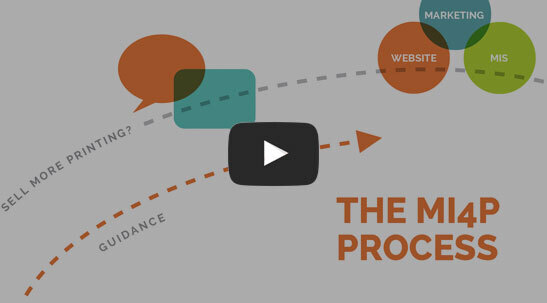Marketers like to talk about the benefits of creating a marketing plan for your print business. After all, marketing is a relevant discipline.
But, how does marketing turn into revenue for your print shop?
To implement your marketing plan, you need four main elements: a good process, the right people, a clear message, and the proper technology.
Whether you’re executing a lead generation campaign or an email marketing campaign, each campaign needs to have its own action plan that drives execution and, ultimately, a return on your marketing investment.
Anatomy of a Marketing Campaign
First, let’s get some definitions out of the way.
Marketing
Marketing is every way you touch a prospect or customer. It’s the action of promoting your products or services. It encompasses tactics like paid advertising, content creation, email marketing, social media marketing, media buying through billboards, radio, and television, as well as video marketing, and the list goes on.
Marketing is not advertising. (You can refer to marketing as advertising if you want to, but be prepared to make a marketer angry like a badger.)
Marketing Plan
A marketing plan gives your print business a high-level strategy based on your business’s objectives over a period of time.
Marketing Campaign
A marketing campaign is a focused, tactical task (or series of tasks) to achieve a specific marketing goal.
Now that we’re all on the same page, let’s get to the anatomy of marketing.
Marketing is no different than any other discipline inside your company. It requires planning, a process, and the right people prior to launch. Because a marketing campaign is tactical and project-based, you need to map out the campaign from the beginning to the final outcome.
You’ll need to identify things like:
- Who’s your ideal audience or persona?
- Who do you want to attract and do business with?
- How are you going to promote your marketing campaign? (Remember, if creating good content is important, promoting it is just as critical.)
- How often do you want to publish your campaigns? No marketing campaign ever resulted in a million-dollar result by executing it only once. You have to be consistent over a long period of time.
- What are the measurables for your marketing campaigns? What do you want to accomplish and how will you measure your performance?
Choose Your Audience Wisely
Before you can choose the what and where of your marketing campaign, you need to determine the who.
The who is ALWAYS the most important step in marketing.
You might be thinking, “we already defined our target audience in our marketing plan.”
In general, you have, but let’s say you offer two services: wide-format printing for large healthcare organizations upwards of 1,000 employees, and simple business cards for real estate offices with around 20 employees.
Which one of these audiences will you target with your marketing campaign, and do you target them both with the same campaign or separate ones?
First, the best way to reach these two very different audiences is to understand their unique pain points and how you can help solve these challenges for each audience. (It’s okay to have multiple personas or audiences.)
Second, you will need to create separate marketing campaigns for each audience. Don’t try and blend them. It only becomes confusing for your potential print buyer, and when prospects are confused, they don’t buy.
Think Demographics
With print buyer personas, you also need to consider demographic data.
Here’s an example:
Let’s say you want to target selling printing solutions to a real estate company. But, you don’t want to sell your printing services to just any real estate company, it has to be one that can afford to buy your stuff.
- Ideally, this real estate office should have more than 30 employees.
- They should generate more than $7M in annual revenue.
- This real estate office should need to outsource their printing items like business cards, 8.5 x 11 pieces of marketing collateral, and wide-format printing for large banners that promote their real estate office at trade show events.
- The owner of this real estate firm should be between 35-55 and make well over six to seven figures, annually.
This is demographic-based data. So, why is this important?
Whether you’re sending direct mail pieces, email campaigns, or paid ad campaigns, you need some sort of contact list. If you want to target the right companies, you need to lay out and determine the criteria that will show you who you should be sending those campaigns to.
To Buy or Not to Buy a List?
If you don’t have contact info or an audience, how can you send marketing campaigns?
You can’t.
So, how do you get them? How can you, the owner of a print business, get contact lists that are good, well targeted, and will get you the result you want?
Organic Lists
The best prospect lists are created organically, not purchased.
These are lists you’ve generated by getting business cards at networking events, working with your Chamber of Commerce, attending high-profile industry trade show events, or by collecting email addresses through email capture on your website.
Purchased Lists
But, what if you don’t have these types of contact lists, and you needed the info yesterday?
The simple answer is you need to buy them.
The pros of list buying are:
- You get instant contact information of decision makers.
- You can easily find your target market by industry segment or SIC (Standard Industry Classification) code.
- You get an instant lift in sales assuming the list is the correct audience.
- And, you build your email list.
The cons of list buying are:
- Lists are typically cold and contacting cold lists can be considered spammy.
- Spamming your new contact lists will impact your brand reputation.
- Often there’s not a 100% sure way to know the health of the list you’re purchasing.
The biggest con with buying contact lists is you can’t immediately use them for email marketing purposes unless you have their permission through some sort of opt-in. CAN-SPAM laws are super important to follow, and these laws are becoming tighter and tighter around randomly using email lists for email marketing campaigns.
For example, if you buy a list with contact email addresses and you immediately start sending your new friends sales emails, you could get your email shut down and blacklisted.
Being blacklisted with any email marketing software solution is bad.
Email marketing companies like MailChimp, Constant Contact, Drip, ConvertKit, GetResponse, and iContact have a very low tolerance for businesses who buy lists and abuse them by sending random stuff.
If you’re going to buy lists that have email addresses, have your list-buying criteria defined up front. Things like type of business, SIC codes, size of the business regarding revenue and employee count, geographic region, etc. Identifying this is paramount to getting the right lists when buying them.
Above all, if you’re going to buy a list, use it wisely.
Promotion Is Queen
Now that you have your ideal print buyer identified, the next step to launching your campaign is deciding what channel to use when communicating your message to attract new buyers.
After all, if content is King, then promoting it to the right audience at the right times and in the right place is the mighty Queen.
Some of these channels might include:
- Your website
- Social media
- Mobile via text message marketing
- SEO/SEM
- Video
- Paid ad campaigns like Google AdWords or Facebook ads
The channels you choose will be different depending on your business, audience, and goals.
For example, if you know your audience spends time on Facebook or LinkedIn, then you need to be on Facebook and LinkedIn. If your audience is searching for your solution to their problem using the search engines, then having a good SEO strategy is paramount over other promotional channels.
Once you’ve determined who your ideal buyer should be and what mediums or channels to put content onto, you’ll want to have a process to nurture your leads over time.
The Art of Nurturing a Lead
Lead nurturing is pretty straightforward.
Lead nurturing is the process of building a relationship with prospects before they become leads through a lead generation campaign.
These prospects are colder in temperature and don’t know much about you or how you can help them. They may be interested but not ready to buy. Lead nurturing is about providing the right content and offers at the right time, educating and delivering value through every stage of the customer journey.
If You Can’t Measure It, Should You Do It?
As you launch your marketing initiatives, it’s important to track your marketing activities to some sort of result or action.
The number one role of marketing is to tell your story so that it supports your sales teams and sales efforts.
That said, you shouldn’t measure marketing by sales. You measure sales by sales. Measuring marketing with net new sales should never be the expectation.
You SHOULD measure your marketing by activity and some sort of agreed-upon scorecard.
Your results will be determined by what your goals were for each campaign. In most cases, results are usually regarding leads that are added to the different stages of your sales funnel and MQLs (Marketing Qualified Leads).
When you’ve completed the cycle of a marketing campaign, ask the following questions in your review:
- Did you meet your goals? Why or why not?
- Did your offer or content resonate with your target audience? If not, what can you do differently?
- What did you learn that you can apply to your next campaign for this audience persona
- What did your data tell you?
Key Things to Remember
- Launching a marketing campaign is not something you do quickly and achieve instant results.
- As much as people love hockey because it’s an instant gratification sport, marketing is not hockey. Immediate results and marketing diametrically oppose one another.
- Each initiative needs to be planned and well thought out before you begin the campaign. Without proper planning, your marketing campaign is likely to fail.
As you launch your campaigns, remember: build your overall marketing plan, determine your ideal print buyer or persona, determine your launch plan with the right content at the right time, promote on the mediums where your audience lives, and measure all that you can.



